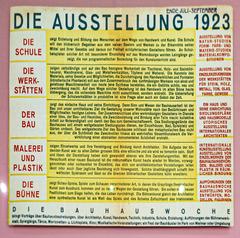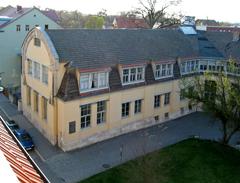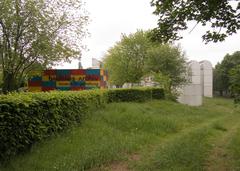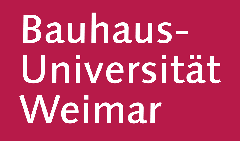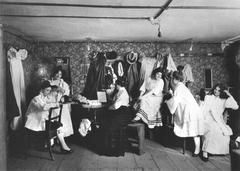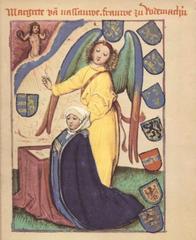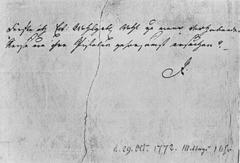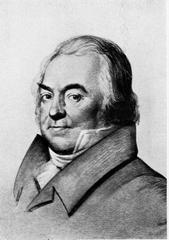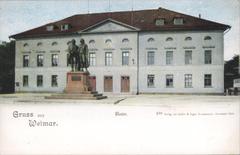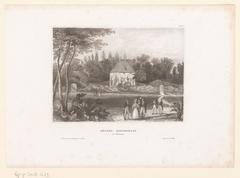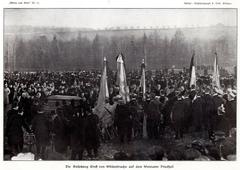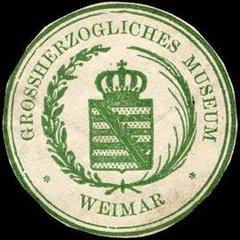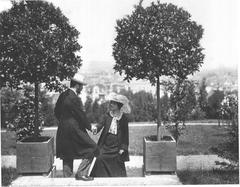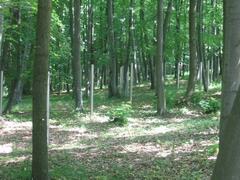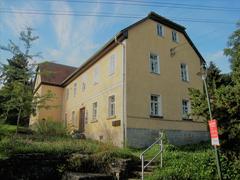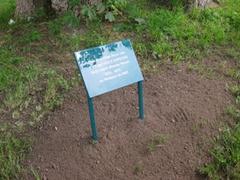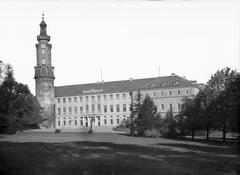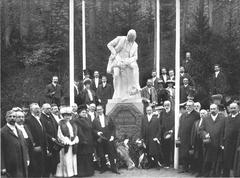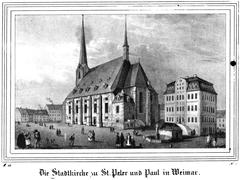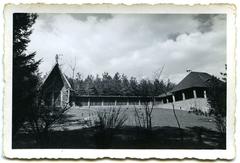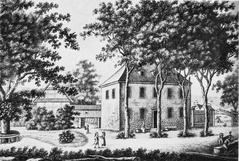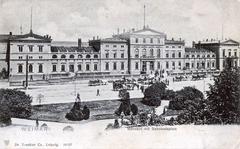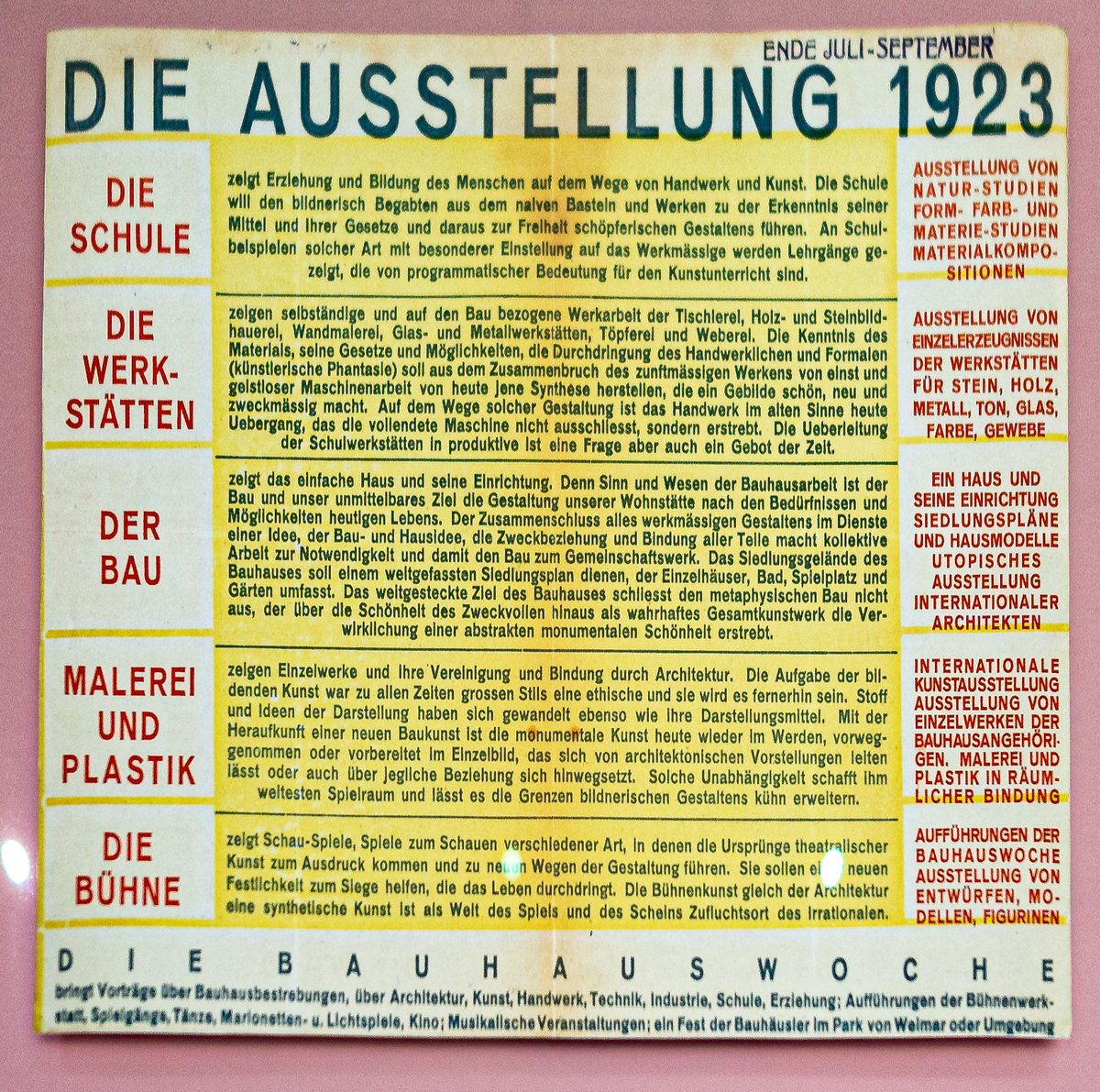
Haus Am Horn Weimar: Visiting Hours, Tickets, and Historical Significance
Date of Publication: 14/06/2025
Introduction
Nestled in the historic city of Weimar, Germany, Haus Am Horn marks a pivotal moment in the evolution of modern architecture. As the first realized building of the Bauhaus movement, it stands as a prototype for functional, affordable living that integrates art, craft, and technology—a vision that shaped the course of 20th-century design. This guide provides a comprehensive overview of Haus Am Horn’s history, architectural innovations, and practical visitor information, including hours, tickets, accessibility, and nearby attractions, to help you make the most of your visit (vielfaltdermoderne.de; e-architect).
Bauhaus Movement and the Weimar Context
Origins and Principles
Founded by Walter Gropius in 1919, the Bauhaus movement emerged in Weimar with the mission to unify art, craft, and technology. The school’s innovative curriculum broke down barriers between the fine and applied arts, fostering interdisciplinary collaboration in workshops focused on carpentry, textiles, metalwork, and more. The guiding principle, “Art and Technology – A New Unity,” positioned the Bauhaus as a response to the societal and economic challenges of post-World War I Germany (vielfaltdermoderne.de).
Bauhaus in Weimar
Weimar, with its cultural legacy shaped by Goethe and Schiller, provided fertile intellectual ground for the Bauhaus. The school became a hub for avant-garde artists and designers, including Paul Klee, Wassily Kandinsky, and Lyonel Feininger. The city’s progressive yet turbulent political climate led to both the school’s early innovations and its eventual relocation to Dessau in 1925 (vielfaltdermoderne.de).
Haus Am Horn: Conception, Architecture, and Significance
Purpose and Design
Conceived as the centerpiece of the 1923 Bauhaus Exhibition, Haus Am Horn was designed by Georg Muche with collaborative input from students and faculty. It was intended as a prototype for affordable, modular housing that addressed postwar shortages, demonstrating how rational planning, modern materials, and integrated technology could shape the home of the future (architectuul.com).
Architectural Features
- Layout: The compact, square plan (12.70 meters per side, c. 120 m²) centers a skylit living room surrounded by bedrooms, study, kitchen, and utility spaces—reflecting a “honeycomb” efficiency that broke from corridor-based layouts (vielfaltdermoderne.de).
- Construction: Innovative use of reinforced concrete and steel, with standardized components for cost-effective, replicable construction. The flat roof, white plastered walls, and steel windows signify modernist aesthetics (zi-online.info).
- Technology: Central heating, hot and cold running water, and built-in kitchen appliances reflected the Bauhaus vision of integrating technology to enhance daily life (bauhaus-movement.com).
Interior and Collaborative Craftsmanship
Every element of the house, from furniture to textiles, was custom-designed by Bauhaus workshops:
- Furniture: Marcel Breuer and Erich Dieckmann created iconic pieces for the living room and bedrooms.
- Lighting: László Moholy-Nagy’s lamps brought modern illumination.
- Textiles and Ceramics: Gunta Stölzl and Theodor Bogler led teams producing carpets and vessels, while Alfred Arndt and Josef Maltan designed color schemes and wall finishes (vielfaltdermoderne.de).
Haus Am Horn as a Social and Cultural Prototype
Intended as more than an architectural experiment, Haus Am Horn embodied the Bauhaus’s social mission: to provide healthy, efficient, and affordable housing adaptable for mass production. Its rational design addressed postwar housing needs and the changing structure of the modern family, influencing subsequent social housing and the International Style (zi-online.info; e-architect).
Visitor Experience: Opening Hours, Tickets, and Practical Information
Location and Access
- Address: Am Horn 6, 99425 Weimar, Germany
- Access: Reachable by local buses (lines 2 and 9 to Eduard-Möricke-Str.), a 20–25 minute walk from the city center, or by car (parking nearby) (fromplacetoplace.travel).
Opening Hours
- Summer (April–October): Wednesday–Monday, 10:00–18:00
- Winter (November–March): Wednesday–Monday, 10:00–16:00
- Closed on Tuesdays
Check for seasonal updates on the official Haus Am Horn website.
Tickets and Admission
- Standard Admission: €5.00 (adults)
- Discounts: Available for students, children, and groups (Klassik Stiftung Weimar ticket page)
- Combo Cards:
- ModernismCard (one-time entry to several Bauhaus sites, valid 365 days)
- WeimarCard (€32.50, 48 hours, includes public transport and museum entry) (annees-de-pelerinage.com)
Booking:
Advance online booking is strongly recommended due to visitor number limitations. Tickets are also available at the Weimar Tourist Information Office or on-site, subject to availability.
Guided Tours and Accessibility
- Guided Tours: Regular group tours (primarily in German), special tactile tours for visually impaired visitors (Thuringia Museum Portal), and English-language tours upon request.
- Accessibility: Step-free access, adapted restrooms, and clear exhibition labeling to distinguish original and reconstructed elements (European Heritage Awards).
Facilities
- Restrooms available on-site.
- No café, but Weimar’s city center offers dining options.
- Bauhaus-themed souvenirs and books at the Weimar Tourist Information shop or online.
Digital Experience
A virtual tour is offered via the Weimar+ app, featuring interactive content and historical context.
What to Expect on Your Visit
- Exhibition: The house is presented as a living museum, with white steel placeholder furniture and reconstructed interiors reflecting the 1923 layout.
- Atmosphere: A peaceful and reflective environment, with limited visitor numbers ensuring an intimate experience.
- Photography: Non-flash photography is allowed for personal use; confirm current policies at entry.
- Visitor Flow: Early mornings and late afternoons are typically less crowded.
Nearby Attractions and Suggested Itineraries
Within Walking Distance
- Goethe’s Garden House: Goethe’s first Weimar residence in Park an der Ilm, set in historic gardens (weimar.de).
- Park an der Ilm: An English-style landscape park with walking paths, classical monuments, and natural beauty (planetware.com).
- Bauhaus Museum Weimar: Extensive Bauhaus collections and exhibitions (weimar.de).
- Bauhaus University Weimar: Historic campus and “Bauhaus Walks” (uni-weimar.de).
- Weimar City Center: Marktplatz, Town Hall, and vibrant cultural scene (planetware.com).
Complementary Cultural Experiences
- Classical Weimar Ensemble: Goethe National Museum, Schiller Residence, Duchess Anna Amalia Library (germanyfootsteps.com).
- German National Theatre: Rich program of operas, plays, and concerts (planetware.com).
- Stadtmuseum Weimar: Urban and social history exhibitions (germanyfootsteps.com).
- Fürstengruft and Historical Cemetery: Burial sites of Goethe, Schiller, and ducal family (komoot.com).
Itinerary Suggestions
- Half-Day Bauhaus Focus: Bauhaus Museum → Park an der Ilm → Haus Am Horn → Bauhaus Walk
- Full-Day Classical Weimar: Goethe’s Garden House → Goethe National Museum → City Center → Theatre performance
- Family-Friendly: Haus Am Horn → Stadtmuseum Weimar → Park picnic
Frequently Asked Questions (FAQ)
Q: How do I get tickets?
A: Book online, at the Weimar Tourist Information Office, or on-site (subject to availability).
Q: Is Haus Am Horn wheelchair accessible?
A: Yes, with step-free access and adapted facilities.
Q: Are guided tours available in English?
A: Primarily in German; English tours are available with advance notice.
Q: Can I take photos inside?
A: Non-flash photography is permitted for personal use.
Q: When is the best time to visit?
A: Early mornings and late afternoons on weekdays see fewer visitors.
Summary Table: Key Visitor Information
| Aspect | Details |
|---|---|
| Address | Am Horn 6, 99425 Weimar, Germany |
| Opening Hours | Wed–Mon: 10:00–18:00 (Apr–Oct), 10:00–16:00 (Nov–Mar); closed Tuesdays |
| Standard Admission | €5.00 (adults); discounts for students, groups |
| Ticket Booking | Online, Tourist Info, on-site (limited) |
| Accessibility | Step-free access, tours for visually impaired |
| Guided Tours | Regular (mainly German), English on request |
| Combo Cards | ModernismCard, WeimarCard |
| Facilities | Restrooms, no café on site |
| Souvenirs | Weimar Tourist Info Shop |
| Digital Experience | Weimar+ app |
| Contact | [email protected], +49 3643 745-0 |
Conclusion
Haus Am Horn stands as a vital testament to the Bauhaus movement’s vision of functional, affordable, and beautiful design. A visit to this UNESCO World Heritage site offers not only an immersion in architectural history but also a gateway to Weimar’s broader cultural treasures. Plan ahead, secure your tickets, and enrich your experience with guided tours, combo cards, and digital resources. Whether you are an architecture enthusiast, a student of design, or a cultural traveler, Haus Am Horn and Weimar’s vibrant heritage await your discovery.
Sources
- vielfaltdermoderne.de
- e-architect
- fromplacetoplace.travel
- weimar.de
- weimar.de (Bauhaus Museum)
- klassik-stiftung.de
- uni-weimar.de
- germanyfootsteps.com
- planetware.com
- annees-de-pelerinage.com
- komoot.com
- parametric-architecture.com
- architectuul.com
- bauhaus-movement.com
- zi-online.info
- Thuringia Museum Portal
- European Heritage Awards
- tallgirlbigworld.com
- wildeast.blog
